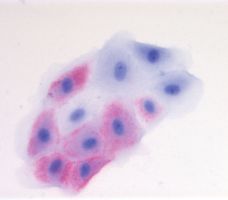
Reproduction
The Viral Hemorrhagic Septicemia virus is just what is sounds
like: a virus. Viruses, technically, are not living. Viruses are
drifting pieces of genetic material, namely DNA or RNA, that are
encapsulated within a protein coat. The do not eat, transpire,
or carry out any other metabolic processes attributed to life.
Even reproduction is not a task that a virus can accomplish on
its own, which is why it requires a host. For VHS, the hosts in
this parasitic relationship are the fish.
Infection of the host begins with contact with the virus. Fish
can be exposed to, and contract the virus in a number of
different ways. Exposure to feces, urine, or other fluids from
infected fish (such as milt) can transfer the virus. The virus
can enter into the fish via an open wound or through the gills
(though rare), and transfer of the virus also occurs when a fish
eats an infected fish. Contaminated eggs can also spread the
disease, and bait fish brought in from infected waters can as
well. This is a main reason for why local governments are trying
to get out the word on VHS, and educate fishermen and other
marine life workers.
 After reaching the fish, the Rhabdovirus (contains
negative-sense, single-stranded RNA) then proceeds to infect
cells of major organs. The virus uses it’s RNA to force the cell
into making more of the virus. When the cell has made enough of
the virus, the virus bursts out of the cell, which leads to
necrosis (cell death).
After reaching the fish, the Rhabdovirus (contains
negative-sense, single-stranded RNA) then proceeds to infect
cells of major organs. The virus uses it’s RNA to force the cell
into making more of the virus. When the cell has made enough of
the virus, the virus bursts out of the cell, which leads to
necrosis (cell death).
VHS (red) invading Gill Epithelium
This widespread necrosis has very damaging effects on the fish, including hemorrhaging of organs or muscle tissue, and swelling of organs or tissue. Sometimes the effects of the virus can be seen externally on the fish as well, such as red spots seen on the surface of the fish.
Back to Prevention Home On to Interactions